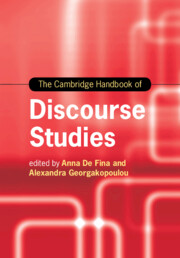Book contents
- The Cambridge Handbook of Discourse Studies
- Cambridge Handbooks in Language and Linguistics
- The Cambridge Handbook of Discourse Studies
- Copyright page
- Contents
- Figures
- Tables
- Contributors
- Preface
- Part I (Con)Textualizing Discourses
- Part II Perspectives and Modes of Analysis
- Part III Discourse Materialities and Embodiment
- 12 Multimodality
- 13 Sign Theory and the Materiality of Discourse
- 14 Discourse and the Linguistic Landscape
- 15 Discourse, Emotions and Embodiment
- 16 Posthumanism and Its Implications for Discourse Studies
- Part IV (Trans)Locations and Intersections
- Part V Ethics, Inequality and Inclusion
- Part VI Discourses, Publics and Mediatization
- Index
- References
12 - Multimodality
from Part III - Discourse Materialities and Embodiment
Published online by Cambridge University Press: 28 September 2020
- The Cambridge Handbook of Discourse Studies
- Cambridge Handbooks in Language and Linguistics
- The Cambridge Handbook of Discourse Studies
- Copyright page
- Contents
- Figures
- Tables
- Contributors
- Preface
- Part I (Con)Textualizing Discourses
- Part II Perspectives and Modes of Analysis
- Part III Discourse Materialities and Embodiment
- 12 Multimodality
- 13 Sign Theory and the Materiality of Discourse
- 14 Discourse and the Linguistic Landscape
- 15 Discourse, Emotions and Embodiment
- 16 Posthumanism and Its Implications for Discourse Studies
- Part IV (Trans)Locations and Intersections
- Part V Ethics, Inequality and Inclusion
- Part VI Discourses, Publics and Mediatization
- Index
- References
Summary
This chapter provides an overview of the recent theoretical, methodological and analytical trends in multimodal research, specifically focusing on how different approaches (e.g. critical discourse analysis, conversation analysis, social semiotics, systemic functional linguistics and interaction analysis) have addressed the complex problems arising from studying the integration of language with other resources, such as images, gesture, movement, space and so forth. In doing so, the chapter discusses how traditional divisions in discourse studies have become somewhat blurred, given the evident need to account for resources other than language and the meaning that arises as choices combine in texts, interactions and events. The chapter also explores how various digital approaches have been developed to handle the multidimensional complexity of multimodal analysis, in particular for the analysis of dynamic media such as videos. This discussion includes the development of mixed methods approaches, purpose-built software, automated techniques and the latest trends in big data approaches to multimodal analysis.
Keywords
Information
- Type
- Chapter
- Information
- The Cambridge Handbook of Discourse Studies , pp. 263 - 281Publisher: Cambridge University PressPrint publication year: 2020
References
Further Reading
This offers an introduction to multimodality from a practice-based perspective and approaches multimodal phenomena from different theoretical perspectives and disciplinary angles.
This provides a comprehensive introduction to various theoretical approaches to multimodality from different disciplines (e.g. visual studies, anthropology, conversation analysis, sociocultural theory, etc.).
This presents an accessible introduction to multimodality that illuminates the potential of multimodal research for understanding the ways in which people communicate. Offering a wide range of examples, clear practical support and a glossary of terms, the book is an ideal reference guide for beginners in multimodal analysis.
This is an essential resource for researchers interested in multimodal communication. Drawing on an enormous range of examples including children’s drawings, textbook illustrations, photojournalism, advertising images, fine art, websites, as well as three-dimensional material artefacts such as sculpture, the book presents a comprehensive account of the ways in which images communicate meaning.
This presents a systematic toolkit of theories, concepts and techniques for carrying out critical discourse analysis of language and images. Based on a variety of case studies and examples drawn from a range of traditional and new media genres, the book is an essential resource for beginners in critical discourse analysis.
References
Accessibility standard: Unknown
Why this information is here
This section outlines the accessibility features of this content - including support for screen readers, full keyboard navigation and high-contrast display options. This may not be relevant for you.Accessibility Information
- 6
- Cited by
